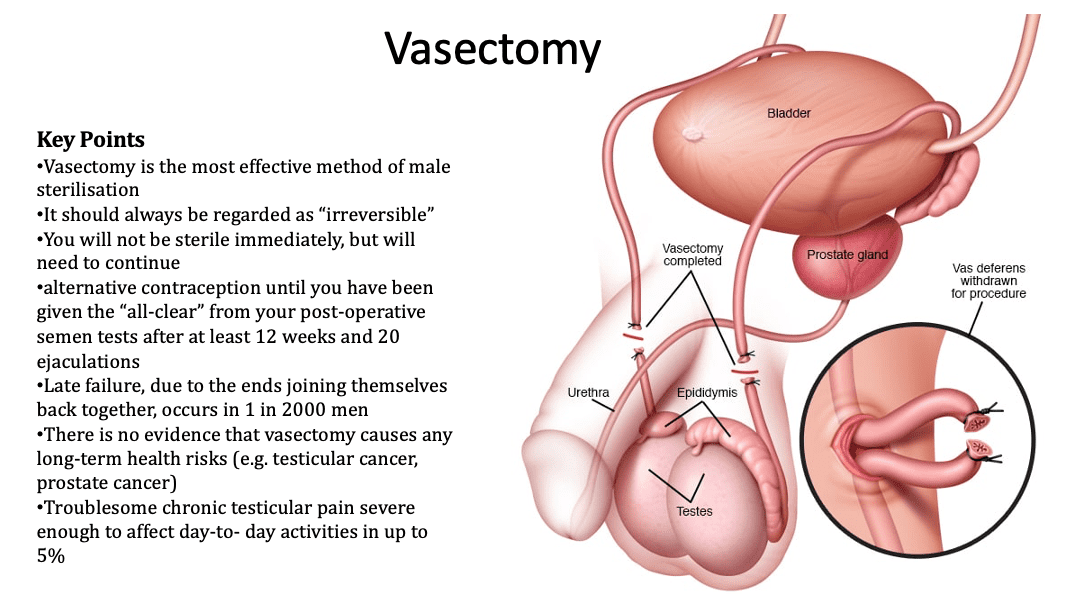Vasectomy
Vasectomy is a method of permanent contraception (sterilisation) reserved for men; to obtain this result, during the vasectomy, the urologist cuts the vas deferens, present at the level of the scrotum, and seals it. This keeps the sperm made by the testicles from mixing with the seminal fluid and making more sperm.
Vasectomy: This is a minor, simple, safe, and very effective surgical operation.
Vasectomy can be performed for various reasons: it can be requested by people who no longer want to have children, or it can represent a way, adopted by some countries, to control births.
There are two types of operative procedures: traditional vasectomy and no-scalpel vasectomy.
Complications can arise like any surgery, but these are very rare.
A brief reminder of the male genital system
The male reproductive system is mainly composed of the following parts:
- Testicles. They are two in number and are responsible for the production of millions of spermatozoa, or male sex cells; they also produce male sex hormones (testosterone), which are essential in the development of primary and secondary sexual characteristics as well as the control of the genital apparatus's functions
- Male genitalia Seminal vesicles and prostate. The seminal vesicles are two and produce a viscous liquid like seminal fluid. On the other hand, the prostate is the gland that makes and releases the seminal fluid needed to feed the spermatozoa and makes up the sperm along with the spermatozoa.
- Ducts deferens. They are the channels that unite the testicles, first to the seminal vesicles and then to the prostate; the spermatozoa flow through them and join the seminal fluid to make up the sperm.
- Urethra. It is a small channel that runs throughout the penis, through which urine and seminal fluid (or sperm, if there are spermatozoa in the seminal fluid) are expelled. The release of seminal fluid is called ejaculation. A muscle valve checks that urine and seminal fluid do not mix.
- Penis. It is the male reproductive organ and the last branch of the urinary tract. Because of the way it is built, sperm can move from a man to a woman through it.

What is a vasectomy?
Vasectomy is a contraceptive surgical procedure reserved for men. Deferentectomy is more correctly referred to; the two-vas deferens are cut and sealed definitively through this intervention. By interrupting these channels, the spermatozoa, coming from the testicles, are prevented from joining and making the seminal fluid produced by the prostate and released with ejaculation fertile.
The equivalent procedure for women, called tubal ligation, is more dangerous and less effective than a vasectomy.

People think of vasectomy as a permanent way to prevent pregnancy, but there is a way to reverse its effects with a specific operation.
For what reason?
Reversal surgery is complicated and often ineffective, even when no complications occur.
Therefore, before undergoing a vasectomy, it is good to know all the details of the operation, from the advantages to the disadvantages.
Many men fear that vasectomy will reduce their libido and sexual performance or predispose them to some severe diseases (cancer and heart disease). However, these are only unfounded fears due to misinformation.
The fears, devoid of any scientific substantiation, which we usually hear about, argue that vasectomy:
- Dramatic sexual performance. Vasectomy does not reduce libido or masculinity; testosterone, erection, and ejaculation hormone levels are entirely normal. The only difference is that the seminal fluid does not contain spermatozoa. Therefore, it cannot be defined as sperm.
- Permanently damage the structures of the genital system. It is rare for vasectomy surgery to cause permanent and irreparable damage to the penis, testicles, or other parts of the male genital system. As will be seen further on, the success rate of the operation is almost 100%.
- You increase the risk of getting cancer. Especially in the past, some believed that vasectomy promoted testicular or prostate cancer. There is no scientific evidence in favour of this thesis.
- You increase the risk of developing heart disease. The same is true for prostate and testicular cancers; there is no scientific link between these and vasectomy.
- You cause severe, sharp pain. Sharp and very intense pain is indeed a sporadic occurrence. The pain is generally mild and disappears in a few days. It is still bearable if it goes on for a more extended period.
In addition, some benefits are erroneously attributed to vasectomy. For example, some believe that the operation protects against sexually transmitted diseases and AIDS, but this is false. The same safety measures and precautions must be taken before the intervention and by anyone else.
Vasectomy is a contraceptive method particularly suitable for those who have decided not to have other children (or not to have any) at some point in life. The reasons can vary greatly and vary from person to person or family to family.
It is a very practised operation, as it is safe and has an almost 100% probability of success; in fact, only one operation every 2000 fails to provide the desired results.
Vasectomy is a method of birth control

In some regions of the world, vasectomy controls the number of births. These are countries, such as China or India, where the birth rate is very high, and there are overpopulation problems.
Preparation
Anyone who has decided to undergo a vasectomy must know what they are going through. So, before the surgery, the urologist will talk with the patient and ask him several times (understood as the person about to have surgery) if he is sure about his decision.
- Remember the permanence of the effects because the choice to undergo a vasectomy may have been a rash choice due to your partner's news of another pregnancy or lousy information. There are, in fact, those who believe that reversal surgery is standard practice and easy to perform.
- They are confronting your partner, even if you have already done so on other occasions. This person may agree but have second thoughts at the time of operation. Nothing prevents an individual from undergoing a vasectomy, even if the partner disagrees; the decision rests solely with the patient.
- Remember other existing methods of contraception, even non-permanent ones. There are, in fact, alternative solutions that are sufficiently effective but not permanent.
- Remember that vasectomy is still a surgical procedure and, as such, can lead to complications.
Before performing the vasectomy, the doctor gives several patients instructions that are valid for the intervention to be successful.
First, he prohibits the intake of aspirin and any other drug with a similar action (warfarin, heparin, etc.). Such treatments must be stopped in time because the pharmacological effects last at least a week.
After that, he requests that the patient: shave the pubic area to be operated on so that washing it is more accessible, and the risk of infection is lower; Get some tight-fitting underpants (also called containment underpants) or tight shorts, to block the movement of the scrotum and minimise swelling; have a relative accompany you, as sitting down to drive could compress the operated area.
Vasectomy is a quick and not particularly painful surgical operation, usually performed under local anaesthesia. During the operation, the urologist cuts and blocks (the technical term for this manoeuvre is ligation) the vas deferens to interrupt every path leading the spermatozoa to union with the seminal fluid.
Generally, the operation is outpatient, and there is no hospital admission; the discharge takes place on the same day as the procedure.
One is the traditional, also called conventional vasectomy, and the other is the one in which no scalpel is used, known as the Anglo-Saxon term "no-scalpel vasectomy" or "no-scalpel vasectomy."
Anesthesia
Anaesthesia is, in most cases, local. So, the scrotum and testicles, which are the parts that will be operated on, are made numb.
The perceived pain is minimal and is more like a nuisance.
When is general anaesthesia used?
During the preoperative tests, the patient declares that he is allergic to local anaesthetics or tends to faint easily, so he is sedated with general anaesthesia.
During general anaesthesia, anaesthetic drugs are administered before and during the entire duration of the operation, which makes the person being operated on entirely unconscious.
The intravenous infusion of sedatives stops when the operation is finished. To get ready for general anaesthesia, you must not eat or drink anything since the night before.

Once local anaesthesia has been performed, the urologist makes two small incisions (about 1 cm) on the right and left of the scrotum.
These incisions represent the access routes to the vas deferens with the scalpel. Once the incision has taken place, part of the canals is removed, and the so-called ligation of the vas deferens, or diathermy, is performed.
At the end of the operation, the incisions are closed with absorbable sutures.
Diathermy closes the vas deferens with the help of a tiny probe that is crossed by an electric current and can make heat.
The advantage of diathermy is that bleeding (i.e., blood loss) is severely limited.
During a no-scalpel vasectomy, the doctor first looks for the vas deferens under the skin of the scrotum and holds it in place with tweezers.
Then, thanks to a particular instrument, he makes a small puncture in the centre of the scrotum; once enlarged very gently, it allows it to reach the vas deferens and cut them (or seal them) in the same way as conventional vasectomy.
Blood loss is minimal, and no stitching is required as the wound heals independently.







